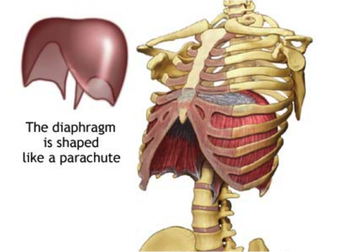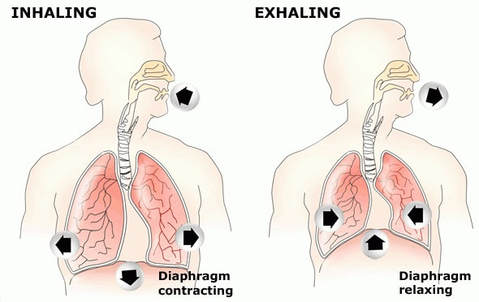The diaphragm!The diaphragm plays a
major role in trunk stabilization and posture by creating and modulating the correct amount of IAP to minimize excessive spinal motion during movement in sports. As the intensity of any activity increases, the tendency is for less diaphragmatic activity and increased
thoracic breathing, or “chest breathing.” Chest breathing is produced by the accessory muscles of respiration, which includes the upper traps and many of the neck muscles. It becomes problematic during breathing when these dominate over the lower muscles such as the diaphragm. Over-activity of these accessory muscles have been also linked to many postural and motor control issues, especially in the neck and shoulders, and reduces the ability to produce sufficient IAP for proper stability during activity.

Okay, so what exactly is diaphragmatic breathing?
Let’s first talk about what it’s not. Diaphragmatic breathing is NOT the same as belly breathing. When someone takes a deep breath and you see only their belly rise, many people think this is the proper cue because it appears they are using the diaphragm correctly – but it’s actually incorrect.
The key to proper diaphragmatic breathing is what we call 360 breathing – where you get 360 degrees of abdominal expansion. We don’t just want a forward distention of the belly as in belly breathing, we want a 3 dimensional expansion – forward, backward, and side-to-side. We want to see this without too much upward movement of the chest. 360 breathing is key for IAP development, and that’s true core stability. The better you can perfect 360 breathing, the more effective those big breathes prior to a 1RM squat will be, and the more efficient your CrossFit workouts will become.

When it comes to our CrossFit and weightlifting workouts, we need to be able to do 2 things well. We need to achieve what the experts call: (1) synchronization with movement and (2) coordination during recovery.
Synchronization with movement is basically the ability to have the diaphragm create the necessary IAP to provide core stability for that specific movement demand. For example – when you are doing a heavy lift, let’s just say a deadlift. Prior to the lift, you inhale. As you initiate the lift, which is typically the heaviest part, you hold that breath which creates your IAP to stabilize. Some people maintain this hold throughout the lift, and some people slowly exhale throughout the lift. Doesn’t matter. The most important aspect was the synchronization of the most IAP with the most difficult part of the lift, which was the initiation. Ideally, we want really good synchronization of breathing during any kind of performance. A great example is the barbell thruster. You all know how important it is to exhale in rhythm at the top of the lift. The key is to take that same concept and apply it to all our movements.
In regards to coordination during recovery, this refers to recovery both during our CrossFit workouts, and afterwards. The goal is to maximize the total amount of air we breathe both in and out as much as possible, which will allow the most oxygen intake and carbon dioxide output. This occurs if the diaphragm is allowed to move through the zone completely….which means minimizing chest breathing.
SO during our workouts we need focus on controlled 360 diaphragmatic breathing, not just when were tired, but from the get-go. Remember – the diaphragm is a muscle, so it responds to stimulus and it can be trained. The more you practice, the better it will function and the better you will feel!
Thanks for reading,
Dr. Andrew

